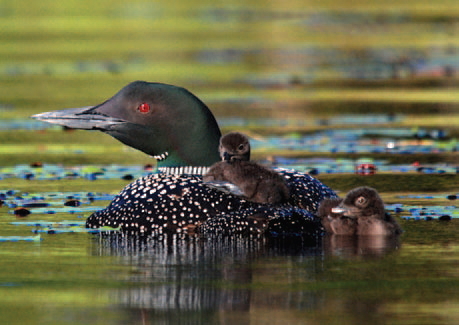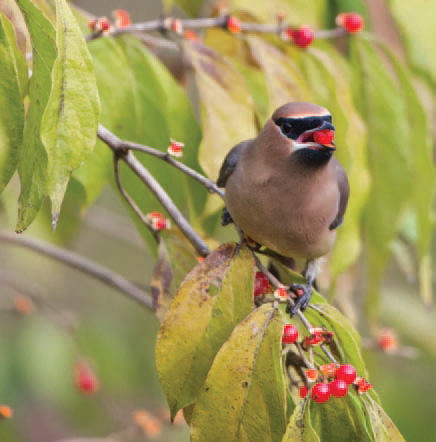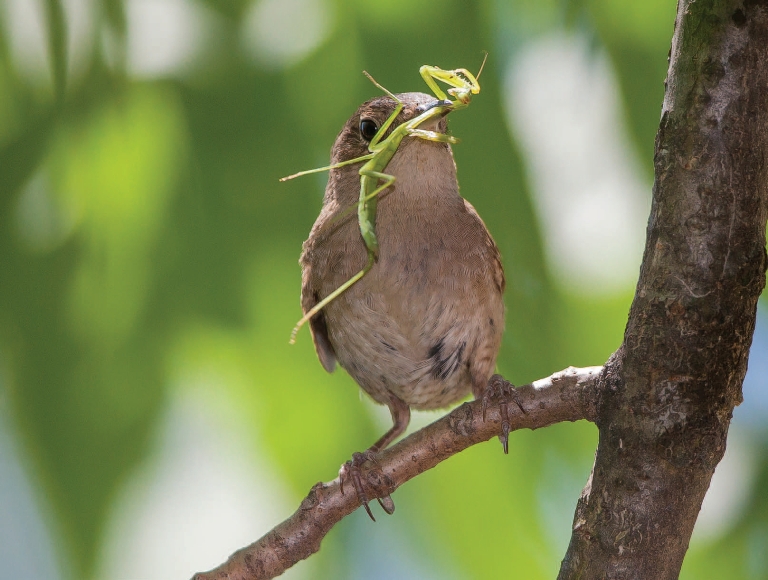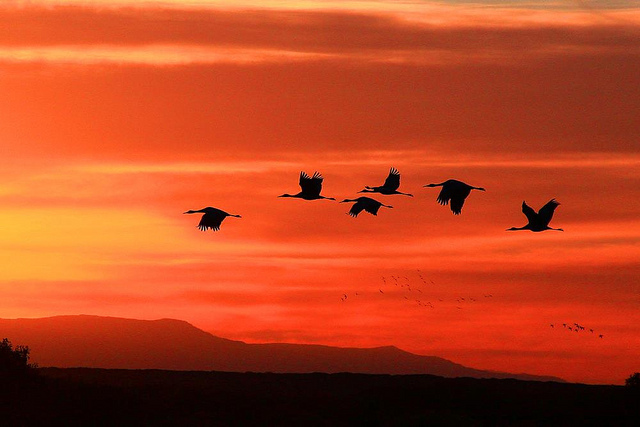Watching and Aiding Migratory Birds
By Krista Schlyer
 Each spring, as the days begin to
lengthen and warm, flowers bloom and insects emerge from the long winter
quiet, many restless. Cedar waxwings look to the skies, golden crowned kinglets
agitate and the wings of white-throated sparrows and sandhill twitch with
anticipation. The annual movement of millions of birds is one of Earth’s
greatest natural phenomena, and woodland not only to witness this winged
spectacle, but to help these weary travelers on their way.
Each spring, as the days begin to
lengthen and warm, flowers bloom and insects emerge from the long winter
quiet, many restless. Cedar waxwings look to the skies, golden crowned kinglets
agitate and the wings of white-throated sparrows and sandhill twitch with
anticipation. The annual movement of millions of birds is one of Earth’s
greatest natural phenomena, and woodland not only to witness this winged
spectacle, but to help these weary travelers on their way.
Whether migrating birds take flight from remote southern rainforests or from our very own backyards, they are driven by the same motivation that spurs all migration: need.
“Birds migrate north because they need access to more food to hatch and feed their young,” explains Peter Marra at the Smithsonian Institution’s Migratory Bird Center in Washington, D.C.
A northward migration from the tropics allows birds to benefit from the profusion of life that flows from south to north as the warmth of spring brings buds on flowers and an explosion of insect populations. Aided by this seasonal bounty, birds hatch and rear their offspring until the days begin to shorten and cool, food in northern climates grows scarce and the south beckons.
“Birds migrate south because after they have fledged their young they need to feed themselves,” Marra states.
 Food scarcity compels animals to
migrate, but it seems birds were made for migration. Their streamlined bodies
and hollow bones make them aerodynamic and light. And given the endurance
demanded by journeys of a thousand miles or more, it’s no surprise that birds
have heart— a big one, in fact. A bird’s heart is six times larger (in
proportion to its body) than the human heart—and can beat 500 to 1,000 times
per minute, depending on the species.
Food scarcity compels animals to
migrate, but it seems birds were made for migration. Their streamlined bodies
and hollow bones make them aerodynamic and light. And given the endurance
demanded by journeys of a thousand miles or more, it’s no surprise that birds
have heart— a big one, in fact. A bird’s heart is six times larger (in
proportion to its body) than the human heart—and can beat 500 to 1,000 times
per minute, depending on the species.
Birds are sharper than ancient mariners at navigation, using stars, the pull of Earth’s magnetic field and even smell to lead them to precise locations year after year. Some birds learn how to migrate from their parents, but others may be born with a genetic sense, as first-year birds have been documented traveling unescorted to a winter home they have never seen before.
Due to the incredible mobility of birds, it is possible to stay in one spot, especially a healthy woodland, and encounter an incredible variety of winged wildlife. Birding is one of the most popular and enduring American pastimes—enjoyed by 50 million people nationwide. For woodland owners, following seasonal bird migrations and getting to know the visiting or nesting birds on your land can be a great way to get some exercise, build relationships with family and friends, and connect on a deeper level to your woods (see below: Basics of Birding).
 More than 650 bird species nest in
North America, and while some of these may live in your woods year-round, the
majority are short- or long-distance migrants. They may travel thousands of
miles across continents, like the Arctic tern, osprey and sharp-shinned hawk,
winging it from South and Central America to northern Canada. Or they may fly
just a few hundreds miles across a state or two, like the house wren and great
blue heron.
More than 650 bird species nest in
North America, and while some of these may live in your woods year-round, the
majority are short- or long-distance migrants. They may travel thousands of
miles across continents, like the Arctic tern, osprey and sharp-shinned hawk,
winging it from South and Central America to northern Canada. Or they may fly
just a few hundreds miles across a state or two, like the house wren and great
blue heron.
Whether their journey is short or long, migration can be grueling and many birds do not survive the trip. Threats to their safe passage range from exhaustion, to collision with cars and buildings, to predation by cats and other creatures.
Protecting winter homes and stepping stones
One of the biggest threats to our feathered friends is something that every woodland owner can help alleviate: habitat loss. Tropical ecosystems where many migrating birds spend their winters are under tremendous pressure from unsustainable logging practices and other agricultural uses. Development and deforestation have also diminished and degraded nesting grounds in northern forests.
And the geographic middle ground is just as important as the endpoints to migratory birds. These “stepping stone habitats” are vital respite stops, says Aimee Weldon, senior director of land conservation at the Potomac Conservancy, which helps private landowners in the Potomac River watershed improve water quality and wildlife habitat.
“Migrating birds have less and less natural habitat to use,” Weldon explains. “And many of the remaining blocks of habitat are privately owned, making family forests very important for birds.” Lack of stopover locations not only reduces the number of birds surviving the trip to winter breeding grounds, it also diminishes a bird’s health and ability to successfully breed. By taking some simple steps on your Tree Farm, you can help provide food, shelter and water for weary winged travelers, making your woodland part of a crucial lifeline for migrating birds (see sidebar: Managing for the Birds).
Managing for the Birds
 A healthy woodland provides a safe
place for birds to live and travel through, but some specific forest practices
can increase the habitat quality for nesting birds and migrants alike. Some
birds, such as cedar waxwings, will be attracted to fruit-bearing trees and
plants, including serviceberry, dogwood, cedar and hawthorn. Others, such as
woodpeckers, flock to deadwood for the protein-rich insects they provide. Here
are some tips for a bird-friendly forest. Many of these revolve around creating
varied, healthy habitat—which can benefit other wildlife and people, too.
A healthy woodland provides a safe
place for birds to live and travel through, but some specific forest practices
can increase the habitat quality for nesting birds and migrants alike. Some
birds, such as cedar waxwings, will be attracted to fruit-bearing trees and
plants, including serviceberry, dogwood, cedar and hawthorn. Others, such as
woodpeckers, flock to deadwood for the protein-rich insects they provide. Here
are some tips for a bird-friendly forest. Many of these revolve around creating
varied, healthy habitat—which can benefit other wildlife and people, too.
• Plant native groundcover, bushes and trees, especially fruit and nut-bearing plants like serviceberry, black cherry, beech and oak.
• Maintain habitat even when cutting trees by practicing single-tree removal, retaining overstory trees or limiting sections of tree removal to one-quarter to 1.25 acres.
• Minimize the impacts of management by avoiding trimming and cutting trees during the breeding season, which for most birds lasts from early spring to late summer.
• Leave deadwood, snags and brush piles. An average of 40 species in a given forest use dead trees and logs for perches and cover, and they are an important source of critters that birds like to eat.
• Manage edge habitat. The area where forest transitions into field can be a very productive area with many diverse species of birds. But predators have an advantage when the forest opens abruptly. You can make edge habitat safer by maintaining a circular or square-shaped forest. Where edges exist, make a transition zone by planting trees sparsely on the forest edge and encouraging the growth of fruit-bearing native shrubs.
• Maximize forest interior. Increase the area of unbroken forest in your woods by eliminating unused roads and other openings that break up the canopy.
More Tips For Bird-Friendly Woodland Management
• Promote the health of waterways and wetlands.
• Maintain a forest buffer of 200 feet to 300 feet around streams.
• Reduce non-native, invasive plant species such as kudzu, English ivy and salt cedar.
• Avoid the use of pesticides and herbicides.
• Keep cats indoors.
• Control deer where overabundant so native plants can thrive.










Comments: